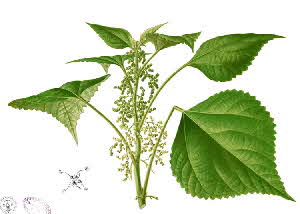|
 Ramie is also known as Chinese nettle and produces a lustrous plant fibre The main species is Boehmeria nivea but there are several varieties and many closely related species. Ramie is also known as Chinese nettle and produces a lustrous plant fibre The main species is Boehmeria nivea but there are several varieties and many closely related species.
a) Biology of Ramie
b) Ramie fibre
c) Uses for Ramie fibre
d) Cultivation of Ramie
e) Harvesting Ramie fibre
f) Processing Ramie fibre
g) History of Ramie fibre
a) Biology of Ramie
Unlike flax, ramie is a perennial plant that may live for several years. It looks similar to European nettle but it does not have prickles. It grows as a shrub up to 1.8 metres tall, with dark green, heart-shaped, crinkly leaves. The underside of the leaves is covered with white hairs, giving it a silvery appearance and the stems are about 1.2 cm thick.
b) Ramie fibre
Ramie fibre is white and lustrous and looks like silk, but it lacks stretch and elasticity. Extremely absorbent, much more than cotton, ramie fabric breathes well and makes comfortable clothing for warm and humid summers. Ramie is one of the strongest natural fibres and it is strong even when wet. Like linen, it will break if folded repeatedly in the same place, so avoid pressing sharp creases or folding ramie fabric. Ramie fabric does not shrink and it is resistant to bacteria and mildew, which means it does not rot easily.
c) Uses for Ramie fibre
Pure ramie can be spun into a fine yarn either dry or wet. You will find it very similar to spinning tussah silk, and when there is static electricity, the fibre clings to your clothes. Before you spin, shake the top a little. Do very little pre-drafting, otherwise the top will fall apart. Pure ramie makes beautiful weaving yarns and Ramie yarns will be stiff at first, but, like flax, will soften with age.
If you want to spin knitting yarns you can add some elasticity by blending ramie with 30% wool. Blended 50/50 with cotton, ramie increases lustre and durability of the cotton fibre. Ramie also blends well with silk.
d) Cultivation of Ramie
Ramie grows well in areas with good rainfall and a warm climate, but it benefits from relatively cold winters. It grows best in a fertile loamy or sandy soil.
I have not yet found plants or seeds for sale in the UK but you may find this plant growing in botanic gardens. Ramie is not completely hardy and, although the shoots die back with the first frost, the plant can survive cold winters providing it is given some protection. Buchanan says that ramie grows well in Washington DC, so it may be possible to grow it in Europe.
e) Harvesting Ramie fibre
The stems are ready to harvest when the flowers begin to open; the stems change colour from green to yellow and the leaves start to drop. They are harvested by machine when most of the stems are ready. In good soils, ramie can be harvested up to 6 times a year.
f) Processing Ramie fibre
Ramie is more difficult to process than other bast fibres because the fibres are held together by gummy resins that do not decompose easily. The usual retting process used for flax and hemp is not effective with ramie. The processing needs to begin as soon as possible after the stems have been cut, otherwise the resin hardens and becomes difficult to remove.
The ramie you buy for spinning has been chemically processed. First the stems were stripped by machines that peel off fibre and bark. Then the resulting strips are scraped to remove the bark. The third stage involves treating the fibres with chemicals to remove the resins. The result is a very fine fibre about 12.5 cm long.
g) History of Ramie fibre
Ramie has been used since pre-historic times in China, India and Indonesia, having been cultivated for over 5 thousand years, which makes it an older crop than cotton in many places. Ramie is one of the commonest fibres used in Japanese textiles.
It is not certain whether ramie was used for mummy cloths in Egypt. Although ramie would be very suitable for the outer mummy cloths as it resists bacteria and mildew, it is difficult to distinguish between flax and ramie in ancient textiles.
In Yichun, China, handmade ramie fabric has been described as “light as cicada’s wings, thin as paper, flat as mirror, slender as silk”. The yarn is very finely spun, not from tops, but from long-hand prepared ramie fibre, which is knotted together to make very long thread. It is then hand woven into a transparent fabric. In South Korea, where there is a museum of ramie cloth, this fabric is called ‘mosi’. You can see the traditional way of processing ramie into translucent fabrics such as mosi in South Korea and Japan in these beautiful YouTube movies - Processing Ramie.
In the 1980s, improvements in processing technology and a renewed interest in natural fibres for clothing brought ramie into wider use. Ramie is still not used much by the textile industry largely because it is a high cost fibre due to its complex processing requirements. Ramie is a premium plant fibre with several useful characteristics and improvements in processing methods may well result in ramie becoming a more popular fibre in the near future.
Ramie is finding new uses in the automotive industry. The Toyota Prius car, for example, uses a range of plant-derived bio-plastics made from cellulose instead of petroleum, and one of the sources of this cellulose is ramie.
Top of page
|

